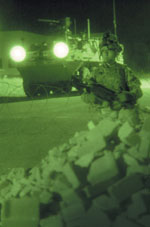Words From the Mouth of The Boots on the Ground
 |
| Spc. Jin Wang, USA, A Company, 2nd Battalion, 1st Infantry Regiment, 5th Stryker Brigade Combat Team, 2nd Infantry Division, kneels near a Stryker, manning a checkpoint during a training raid. The vehicles have proven themselves valuable assets for troops in combat areas. |
The Stryker is a rarity in the military world—an item that satisfies the top commanders and warfighters seeing action in battle. While support from the top does not always translate into success on the ground, in the case of the Stryker the troops in combat, including those using it for communications missions, are basically as pleased with the vehicle as are the planners and decision makers in the
Capt. Joseph Gardner, USA, recently served as the commander, 566th Signal Company, 2nd Stryker Brigade Combat Team, 25th Infantry Division, Multi-National Division–Baghdad. The captain remains in
Overall, the signal commander is happy with the Stryker, but he would like to see some alterations to its components. He explains that although he could not ask for anything better out of the vehicle itself, “We just need to improve some of the communications systems in it.” According to Capt. Gardner, the Stryker enables signal soldiers to join the formation of the maneuver elements to conduct missions throughout the brigade’s area of operation without taking away from the maneuver unit combat power. “Basically, it provides the signal soldier with his [or] her own transportation to get to the fight and transport the required gear without absorbing space that should be allocated to the warfighters,” the captain says.
The Stryker enhances signal missions by providing signaleers with the same combat fire power capabilities employed by the maneuver elements they support. “Additionally, it provides excellent survivability as signal soldiers travel around the battlefield,” Capt. Gardner says. Also beneficial is the easy modification to support various communications platforms for any mission. During an exercise at
In combat, the signal company employed the operational Mounted Battle Command on the Move system, which provides secret Internet protocol router network data and voice on the move to the brigade commander. The system is satellite-based and connects to the Joint Network Transport Capability-Spiral (JNTC-S) architecture via a satellite communications flyaway package system connected directly to the Joint Network Node via fiber. According to Capt. Gardner, selected Strykers in the brigade additionally were outfitted with Wide-band on the Move systems and Tacticomp, a wireless and Global Positioning System-enabled handheld computer designed for field use. Each command post has a base station replica of the vehicular version.
All Stryker vehicles in the captain’s former brigade are equipped with Force XXI Battle Command, Brigade-and-Below (FBCB2)/Enhanced Position Location Reporting System (EPLRS)-based lower tactical Internet systems. Select vehicles also are outfitted with Blue Force Tracking (BFT). “Every command post in the brigade has either an FBCB2/EPLRS or a BFT base station or both,” the captain explains. His signal company had five Strykers dedicated to it. Of the five, three were for frequency modulation (FM) retransmission work and two were for EPLRS. However, the technology was interchangeable and could be modified to fit mission requirements.
Signal Strykers are slightly different than regular infantry Strykers because of the additional communications systems. Most regular infantry have only one complete radio system; a signal company could have up to four depending on its mission requirements. The EPLRS-configured Strykers would contain three EPLRS radios instead of one. Signal soldiers also could remove an EPLRS radio and put in an additional FM retransmission tool. The basic configuration contains two retransmission networks in the FM retransmission-dedicated Strykers and three EPLRS radios in the EPLRS-dedicated Strykers.
Capt. Gardner says that of the systems currently in use by this brigade, only the Mounted Battle Command on the Move system and the FBCB2/EPLRS tie into the JNTC-S architecture. The other systems are stovepiped; but, according to Capt. Gardner, as these systems improve to become programs of record and receive joint interoperability certification, they should be integrated into the JNTC-S/Warfighter Information Network-Tactical architecture.
Of all the tools available to signal soldiers via the Stryker, Capt. Gardner can identify two that were most important in his role as a signal commander of a Stryker Brigade Combat Team in
In terms of the most useful technology, Capt. Gardner singles out the Remote Weapons System. This technology is designed to allow the Stryker gunner to zoom in on the target before firing. Signal troops use it to pinpoint passable trails and to identify possible flat terrain to establish retransmission/relay stations.
 |
| Local children wave at the soldiers as a Stryker vehicle rolls down a street in Sab al Bour, northwest of Baghdad. Soldiers in country use the Stryker for daily missions. |
Beyond those duties, soldiers are using the Strykers to perform personal security details support for the brigade command group as well as to conduct assault missions with the brigade assault task force team. “Soldiers from the signal company have been attached to those teams, and having the Stryker made it easier to integrate them because they are subject matter experts on all the Stryker systems,” Capt. Gardner explains.
The captain notes that often signal troops do not use their Strykers for the intended purpose. Because all the retransmission sites are at fixed stations on something secure, personnel can employ the vehicles on other missions for the brigade. Capt. Gardner describes these non-signal operations as “more or less infantry maneuver missions.” The Strykers would still be occupied by signal soldiers, and all the communications equipment would remain in place. In other missions, the signal troops play support roles and provide additional communications. “We do a lot of dual-role stuff,” Capt. Gardner explains.
Capt. Gardner has operated in other tactical vehicles, but he touts the Stryker as an improvement over others he has used. “Hands down, the Stryker has more interior space, which makes it easier to pinpoint and repair faults,” he says. “Additionally, the computer diagnostics system makes it very easy to identify faults with the communications systems.” Other benefits he identifies include the Stryker’s ability to cover a vast area rapidly and to carry the equipment load required to complete the mission.
The Stryker also can access just about any location. Signal company soldiers, for example, drove one Stryker to the high drivable retransmission site at the
While pleased overall with the Stryker, the captain does admit that the vehicle has some shortcomings in signal capabilities. One of the main changes he would like to see is an adjustment from the multiple internal coaxial cables to one cable that runs directly from the antennas to the radio systems using the shortest distance possible. This would help eliminate loss of connectivity. He explains that the problem with the current setup is that cables are run to a signal entry panel that splits in two directions, with one cable going to the antenna and another cable going to the radio system. “Through trial and error to improve communications, we determined that we were receiving [radio frequency] loss at the signal entry panel,” he explains. After troops ran a single cable between the radio and the antenna, communications improved drastically. Capt. Gardner says he really likes that multiple cables run to the signal entry panel and that those cables are interchangeable.
Another issue with the vehicle is that the Stryker’s height often causes the antennas to strike high-tension power lines, and in the urban areas of war zones many obstacles pose a hazard that could hurt vehicles and troops. Capt. Gardner would like to see the replacement of the AS-3900 antenna with the Low Profile AS-3916 antenna. With the AS-3916, soldiers would not need to pull down the antenna but could still obtain the same range.
An additional problem the captain identifies deals with the company’s EPLRS Strykers. Those two vehicles are designed to be EPLRS network managers and gateways to bridge two brigade EPLRS networks. “Currently, the gateway system doesn’t work with the software version 6.4 because 6.4 is IP [Internet protocol] based,” he explains. “Through preliminary testing it was determined that this system must have a router installed in order to route the EPLRS traffic between the two networks.” More testing will be conducted by a Stryker brigade combat team to validate that router concept.
The captain emphasizes that signal troops want communications that are interchangeable, not systems that are stovepiped, and they want to have communications with any other units in their groups. He also stresses that, “We truly want multiple means of communication.” On all Strykers, commanders want to pick up a voice telephone, call for information and pull down a video feed. The captain explains that communications soldiers are providing those functions with some systems, but that the capabilities need to be tied into one network.
He also shares that various groups, such as the U.S. Army Communications and Electronics Command (CECOM), need to become involved in improving some of the communications aspects, and he adds that the command already is taking some of the lessons learned and implementing them on the vehicles. Capt. Gardner has sent back to CECOM lessons learned of his own that he hopes will improve operations.
Web Resources
Stryker Brigade Combat Team Project Management Office: www.sbct.army.mil
Project Manager, Force XXI Battle Command Brigade and Below: http://peoc3t.monmouth.army.mil/fbcb2/fbcb2.html
Enhanced Position Location Reporting System: www.monmouth.army.mil/peoc3s/trcs/MainEPLRS.htm
A Consolidated Version of Land Warrior Will Deploy With Strykers The U.S. Army’s Land Warrior program has found new breath, even though its existence is only on temporary life support. The canceled effort now is being rolled into the Ground Soldier Ensemble, but some of its capabilities are relevant to current field requirements. To meet those needs, the Army is equipping a Stryker unit with a modified version of Land Warrior to offer warfighters the tools they need for success on the battlefield. Because of funding restrictions, the Army terminated the Land Warrior program. However, the system performed well in combat and received such favorable reports from the troops who used the equipment that leadership decided to close the gap in capabilities by deploying Land Warrior with a new Stryker brigade until Ground Soldier Ensemble is ready to roll out. The entire 5th Brigade, 2nd Infantry Division Stryker Brigade Combat Team will be equipped with the Land Warrior ensembles and vehicle integration kits. The reworked Land Warrior technology will be delivered around April and in the meantime, system developers are training the Stryker brigade combat team with the older version. The team will be trained and ready to deploy by summer. Lt. Col. Brian Cummings, The difference between the Land Warrior system originally deployed and the new Stryker version is consolidated boxes and hence less weight. According to Col. Cummings, the form critiques submitted by soldiers in the field have shown that troops love the system’s capabilities, and that they use them on every operation. The criticism the warfighters had was that the load and weight were too much. For the new deployment, the Land Warrior will be two pounds lighter (eight pounds versus 10 pounds). While the newest version is only two pounds lighter than the previous version, it is nine pounds lighter than the first system provided for fielding. Besides the weight reduction, soldiers will have fewer boxes to wear, though the basic components remain the same. Fewer boxes also reduce the number of cables and potential failures the system could have. The 5th Brigade, 2nd Infantry Division managed to acquire the new systems for its deployment by issuing an operational needs statement. The commander of the brigade exchanged information with the commander of the 4th Battalion, 9th Infantry Regiment of the 4th Brigade Combat Team (Stryker), 2nd Infantry Division, about the systems’ success. That unit was the first unit to deploy with Land Warrior; the group recently redeployed after 15 months in theater. According to Col. Cummings, the 5th Brigade, 2nd Infantry Division commander was so intrigued by what he learned about the capabilities that he set out to acquire them for his unit’s deployment. Despite the perceived value of the system, the colonel stresses that the deployment of the lighter Land Warrior is only a gap-filler and that only enough systems for the one brigade will be built. However, the Army will benefit from having the capability in theater, and the lessons learned could influence Ground Soldier Ensemble. Under that new program of record, brigades of systems will be built with a focus on decreasing soldier load. Col. Cummings shares that one of the great features of Land Warrior is that lessons learned drive the engineering and development of the system, so the drive comes from soldiers using the devices, not engineers sitting at desks. Ground Soldier Ensemble will take the best parts of the Land Warrior system and then promote competition in industry to improve parts the private sector produces exceptionally well, such as computers. Implementing the first-rate pieces of Land Warrior ensures that soldiers will continue to access the capabilities they require. Jason Regnier, deputy product manager, Land Warrior, says, “The way to think of this is Land Warrior has led the way for what we say is the dynamic change in the way the U.S. Army will fight.” The system delivers the network to dismounted soldiers as well as allows soldiers to operate in the dark and still maintain speed. “It’s really a revolution in the way we fight,” Regnier states. Before, the best communications soldiers had was voice; now they can see targets and objectives. To incorporate all of Land Warrior into a smaller package and provide it to the Stryker Brigade Combat Team, the Army contracted with General Dynamics C4 Systems (GDC4S), which has been working on the system and its evolutions since 2003. “What really drove the size, weight and power down was we skimmed down capabilities and features the soldiers didn’t use on a regular basis or they didn’t feel was operationally effective,” Mark Showah, director of Integrated Systems in GDC4S’s Battle Management business area, explains. The engineering team consolidated boxes, eliminated housing, developed more standard interfaces and reduced power needs so soldiers do not need multiple signal conversions. In addition, the helmet interface adapter that converted video signals from the helmet-mounted display was able to integrate into the new computer system. Because Stryker Brigade missions tend to be shorter than other units’ missions, developers and soldiers found they could recharge batteries in the vehicle. That discovery led to the weight drop from past configurations because personnel eliminated a full battery, but troops could still run 12-hour batteries and power the system. The Army’s commitment to changing Land Warrior based on user input has affected how GDC4S evolved the system. Soldiers from the 4th Battalion, 9th Infantry Regiment of the 4th Brigade Combat Team (Stryker), 2nd Infantry Division Regiment worked with GDC4S engineers to look at the system’s packaging and provide input on the human engineering factor. Showah explains, “Before committing software changes or capability changes to code, we would do rapid prototypes and show those to the soldiers so they could adjust that before we adjusted the code. That allows us to get it right the first time.” |




Comments